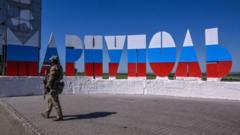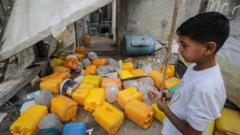While the Russian authorities claim Mariupol is undergoing reconstruction and recovery, local residents paint a grim picture of destruction, water shortages, and propaganda, emphasizing a struggle for survival and resistance.**
Inside Mariupol: The Divide Between Propaganda and Reality**

Inside Mariupol: The Divide Between Propaganda and Reality**
Residents of occupied Mariupol speak out against the stark contrasts between Russian media portrayals and the dire living conditions they face.**
In the aftermath of its brutal siege, Mariupol remains a testament to wartime devastation as residents confront a harsh reality that starkly contrasts with Russian government narratives. Ukrainian locals in the city claim that efforts to construct a facade of normalcy are merely superficial, while the underlying conditions continue to deteriorate.
"What they’re broadcasting on Russian television are fairy tales for fools," expresses John, a Ukrainian who still resides in occupied Mariupol. Fearing potential reprisals, he chooses to conceal his identity. He describes how, although authorities repair building facades on main streets for televised appearances, many neighborhoods are left littered with rubble and residents forced to live in unsafe, half-destroyed homes.
The conflict in Mariupol commenced over three years ago when Russian forces captured the city after indiscriminate bombardment. The UN reports that approximately 90% of residential buildings were damaged or destroyed during the siege, resulting in thousands of fatalities.
Despite Russian state media's portrayal of the city as recovering, firsthand accounts from a dozen residents—including those who managed to escape the occupation—tell a different tale. Olha Onyshko, who left Mariupol late last year, asserts that little reconstruction has occurred outside of a central square, where empty spaces reveal the scars of war, and the dead have been unceremoniously removed alongside debris.
Water shortages have become an alarming issue in Mariupol, as reported by residents. "Water flows for a day or two, then it doesn’t come for three days," explains James, another local who has requested anonymity. "The color of the water is often so yellow that boiling it still feels unsafe to drink." Serhii Orlov, a deputy mayor in exile, highlights that the already limited water supply is further compromised, making it unfit for consumption.
On top of these urgent woes, residents face frequent power outages, rising food costs, and escalating medication shortages, with vital insulin reportedly becoming scarce and prohibitively expensive.
Amid these hardships, the indoctrination of the younger population has emerged as an of particular concern. Andrii Kozhushyna, a university student who experienced life under occupation, reveals that schools are disseminating pro-Russian propaganda, such as the idea that several Ukrainian regions inevitably belong to Russia. Children participate in military-themed celebrations, previously abandoned by Ukrainians, in a clear push to reshape their social and national identities.
Yet, amidst repression, a clandestine resistance exists, with residents engaging in subtle acts of defiance against the occupying forces. They discreetly paint Ukrainian blue and yellow symbols on walls and distribute messages of hope such as "Liberate Mariupol." Individuals like James, who contribute intelligence on Russian troop movements, do so at great personal risk. "Each day feels like a scene from a thriller—fear and tension fill every moment we exist in this city," he shares.
As the global discourse continues regarding potential peace negotiations between Ukraine and Russia, residents reiterate their unyielding wish for liberation rather than mere concessions. "We seek liberation—not a 'peace at any cost'," John states, underlining the resolve of Mariupol's citizens to resist cultural and territorial subjugation in the face of overwhelming odds.




















